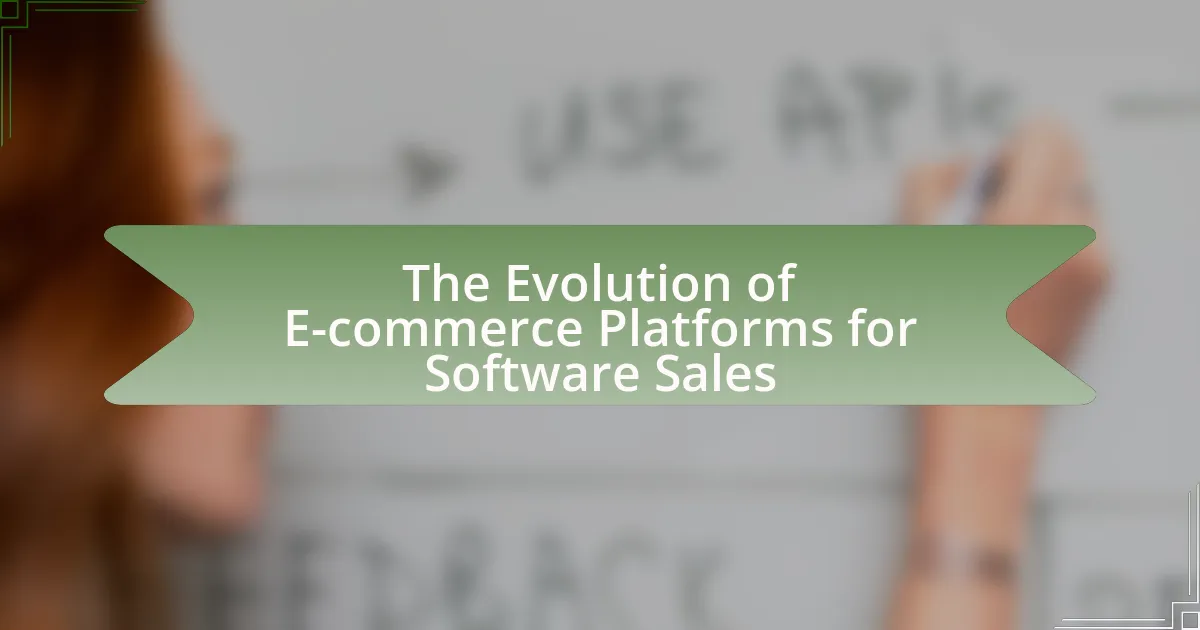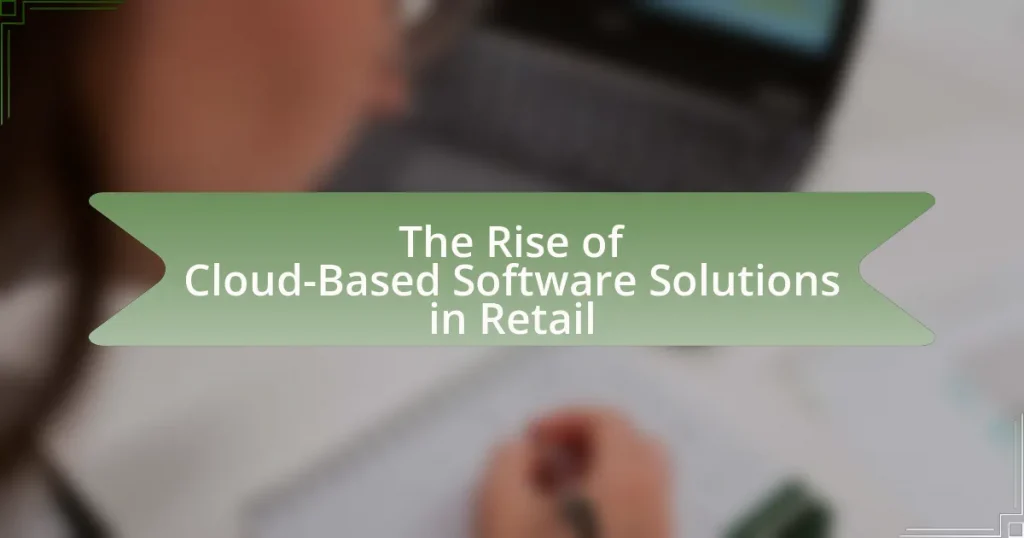The article focuses on the evolution of e-commerce platforms for software sales, tracing their development from the late 1990s with early online marketplaces to the rise of dedicated platforms and subscription-based models. It highlights key milestones, such as the launch of eBay, Amazon, and the Apple App Store, and discusses how these platforms have transformed the software sales landscape by enabling global access, streamlining purchasing processes, and enhancing user experience. Additionally, the article examines the impact of consumer behavior on platform development, the differences between B2B and B2C platforms, and the role of technological advancements like cloud computing and artificial intelligence in shaping future trends. It also addresses challenges faced by e-commerce platforms, including security concerns and regulatory compliance, while providing best practices for businesses selecting suitable platforms for software sales.
What is the Evolution of E-commerce Platforms for Software Sales?
The evolution of e-commerce platforms for software sales began in the late 1990s with the emergence of online marketplaces like eBay and Amazon, which allowed software developers to reach broader audiences. In the early 2000s, dedicated platforms such as the Apple App Store and Microsoft Store were launched, enabling developers to distribute software directly to consumers while providing a secure payment system. By the 2010s, subscription-based models gained popularity, exemplified by platforms like Adobe Creative Cloud, which shifted software sales from one-time purchases to ongoing subscriptions. This evolution reflects a trend towards increased accessibility, user-friendly interfaces, and diverse monetization strategies, adapting to consumer preferences and technological advancements.
How have e-commerce platforms transformed the software sales landscape?
E-commerce platforms have significantly transformed the software sales landscape by enabling direct access to a global market, streamlining the purchasing process, and facilitating digital distribution. These platforms allow software vendors to reach customers worldwide without the need for physical storefronts, which has expanded their market reach exponentially. For instance, according to Statista, global e-commerce sales are projected to reach over $6 trillion by 2024, highlighting the growing importance of online sales channels. Additionally, e-commerce platforms provide automated payment processing and instant delivery of digital products, enhancing customer convenience and satisfaction. This shift has led to a rise in subscription-based models and software-as-a-service (SaaS) offerings, which have become prevalent due to their flexibility and lower upfront costs for consumers. Overall, e-commerce platforms have revolutionized how software is marketed, sold, and delivered, making it more accessible and efficient for both vendors and customers.
What key milestones mark the evolution of these platforms?
Key milestones in the evolution of e-commerce platforms for software sales include the launch of the first online marketplace, which was eBay in 1995, enabling peer-to-peer sales. In 1999, Amazon expanded its offerings to include software, marking a significant shift towards comprehensive e-commerce solutions. The introduction of digital distribution platforms like Steam in 2003 revolutionized software sales by allowing users to purchase and download games directly. The emergence of subscription-based models, exemplified by Adobe’s transition to Creative Cloud in 2013, further transformed the landscape by prioritizing recurring revenue over one-time purchases. Each of these milestones reflects significant advancements in technology and consumer behavior, shaping the current state of e-commerce for software sales.
How have consumer behaviors influenced platform development?
Consumer behaviors have significantly influenced platform development by driving the need for user-friendly interfaces and personalized experiences. As consumers increasingly demand seamless navigation and tailored recommendations, platforms have evolved to incorporate advanced algorithms and intuitive designs that enhance user engagement. For instance, the rise of mobile shopping has prompted platforms to prioritize mobile optimization, leading to the development of responsive designs and mobile applications. Additionally, consumer preferences for social proof and reviews have led platforms to integrate user-generated content and rating systems, fostering trust and encouraging purchases. These adaptations reflect a direct response to consumer expectations, illustrating how platform development is closely aligned with evolving consumer behaviors.
What are the primary types of e-commerce platforms for software sales?
The primary types of e-commerce platforms for software sales include SaaS (Software as a Service) platforms, marketplace platforms, and self-hosted e-commerce solutions. SaaS platforms, such as Shopify and BigCommerce, provide hosted services that allow software vendors to sell their products without managing infrastructure. Marketplace platforms, like Amazon and eBay, enable software developers to list their products alongside other vendors, reaching a broader audience. Self-hosted e-commerce solutions, such as WooCommerce and Magento, offer more customization and control for businesses that prefer to manage their own servers and software. These distinctions are crucial for software vendors to choose the right platform based on their business model and target audience.
What distinguishes B2B from B2C e-commerce platforms?
B2B e-commerce platforms are distinguished from B2C platforms primarily by their target audience and transaction complexity. B2B platforms cater to businesses, facilitating bulk transactions, long-term contracts, and often customized pricing structures, while B2C platforms focus on individual consumers, emphasizing straightforward purchasing processes and lower transaction volumes. For instance, according to a report by Statista, the global B2B e-commerce market is projected to reach $25.6 trillion by 2028, highlighting the scale and complexity of B2B transactions compared to the B2C market, which was valued at approximately $4.9 trillion in 2021. This significant difference in market size and transaction nature underscores the distinct operational models and strategies employed by B2B and B2C e-commerce platforms.
How do subscription-based models differ from one-time purchase models?
Subscription-based models provide ongoing access to a product or service for a recurring fee, while one-time purchase models require a single payment for permanent ownership. In subscription models, users typically receive continuous updates, support, and new features as part of their subscription, which can enhance user experience and retention. In contrast, one-time purchases often involve a fixed version of the product without ongoing updates or support unless additional fees are paid. This distinction is evident in software sales, where companies like Adobe have shifted from one-time purchases of software to subscription-based models, resulting in a more predictable revenue stream and increased customer engagement.
What technological advancements have driven the evolution of these platforms?
Cloud computing has significantly driven the evolution of e-commerce platforms for software sales by enabling scalable infrastructure and flexible resource management. This advancement allows businesses to host applications and services online, reducing the need for physical servers and facilitating easier access for users. Additionally, the rise of mobile technology has transformed user engagement, as platforms now offer mobile-friendly interfaces and applications, catering to the increasing number of consumers using smartphones for purchases. Furthermore, advancements in payment processing technologies, such as digital wallets and blockchain, have enhanced transaction security and efficiency, fostering consumer trust and encouraging online sales. These technological developments collectively contribute to a more robust and user-centric e-commerce environment for software sales.
How has cloud computing impacted software sales platforms?
Cloud computing has significantly transformed software sales platforms by enabling scalable, on-demand access to software applications. This shift allows vendors to offer subscription-based models, reducing upfront costs for consumers and facilitating easier updates and maintenance. According to a report by Gartner, the global public cloud services market is projected to grow to $397.4 billion in 2022, illustrating the increasing reliance on cloud-based solutions. Additionally, cloud computing enhances collaboration and integration capabilities, allowing software sales platforms to provide a more seamless user experience and access to a broader range of applications.
What role do payment gateways play in e-commerce platform functionality?
Payment gateways are essential components of e-commerce platform functionality, facilitating secure online transactions between customers and merchants. They enable the processing of credit card and other payment methods, ensuring that sensitive financial information is encrypted and transmitted securely. According to a report by Statista, the global payment gateway market is projected to reach $45 billion by 2026, highlighting their critical role in supporting the growth of online sales. By integrating payment gateways, e-commerce platforms enhance user trust and streamline the checkout process, ultimately driving sales and improving customer satisfaction.
How do e-commerce platforms enhance user experience in software sales?
E-commerce platforms enhance user experience in software sales by providing streamlined purchasing processes, personalized recommendations, and comprehensive customer support. These platforms simplify transactions through user-friendly interfaces that allow customers to easily browse, compare, and purchase software products. For instance, features like one-click purchasing and secure payment options reduce friction in the buying process, leading to higher conversion rates. Additionally, personalized recommendations based on user behavior and preferences help customers discover relevant software, improving satisfaction and engagement. Comprehensive customer support, including live chat and extensive FAQs, further enhances the user experience by addressing inquiries and issues promptly, which is crucial in the software sales environment where technical questions often arise.
What features are essential for improving customer engagement?
Essential features for improving customer engagement include personalized communication, user-friendly interfaces, and responsive customer support. Personalized communication enhances customer relationships by tailoring messages and offers based on individual preferences and behaviors, which can increase engagement rates significantly. User-friendly interfaces ensure that customers can navigate the platform easily, leading to a better overall experience and higher retention rates. Responsive customer support addresses customer inquiries and issues promptly, fostering trust and loyalty. Research indicates that companies with effective customer engagement strategies can see up to a 20% increase in sales, highlighting the importance of these features in driving engagement.
How do personalization and recommendation systems work in these platforms?
Personalization and recommendation systems in e-commerce platforms for software sales analyze user behavior and preferences to deliver tailored content and product suggestions. These systems utilize algorithms that process data such as past purchases, browsing history, and user ratings to identify patterns and predict future interests. For instance, collaborative filtering techniques compare a user’s behavior with that of similar users to recommend software that others with similar tastes have purchased. Additionally, content-based filtering examines the attributes of software products and matches them with user preferences, enhancing the relevance of recommendations. Research indicates that personalized recommendations can increase conversion rates by up to 300%, demonstrating their effectiveness in driving sales and improving user experience.
What challenges have e-commerce platforms faced in the software sales sector?
E-commerce platforms in the software sales sector have faced significant challenges, including intense competition, security concerns, and the need for compliance with various regulations. Intense competition arises from numerous platforms vying for market share, which pressures pricing and customer acquisition strategies. Security concerns are paramount, as software sales often involve sensitive customer data, making platforms vulnerable to cyberattacks; for instance, a 2021 report indicated that 43% of cyberattacks target small businesses, highlighting the risks involved. Additionally, compliance with regulations such as GDPR and CCPA requires platforms to implement stringent data protection measures, complicating operations and increasing costs. These challenges collectively impact the efficiency and profitability of e-commerce platforms in the software sales sector.
How do security concerns affect consumer trust in e-commerce platforms?
Security concerns significantly diminish consumer trust in e-commerce platforms. When consumers perceive a risk of data breaches, identity theft, or fraud, they are less likely to engage in online transactions. According to a 2021 survey by the Pew Research Center, 81% of Americans feel that the potential risks of sharing personal information online outweigh the benefits, highlighting the critical impact of security perceptions on consumer behavior. Furthermore, a study published in the Journal of Retailing and Consumer Services found that enhanced security measures, such as SSL certificates and secure payment gateways, positively influence consumer trust and willingness to purchase. Thus, the presence of security concerns directly correlates with reduced consumer confidence in e-commerce platforms.
What are the implications of regulatory compliance for these platforms?
Regulatory compliance for e-commerce platforms in software sales entails adherence to laws and regulations that govern data protection, consumer rights, and financial transactions. This compliance impacts operational practices, requiring platforms to implement robust data security measures, ensure transparent pricing, and facilitate fair return policies. For instance, the General Data Protection Regulation (GDPR) mandates strict data handling protocols, compelling platforms to invest in privacy measures to avoid hefty fines, which can reach up to 4% of annual global turnover. Additionally, compliance with the Payment Card Industry Data Security Standard (PCI DSS) is essential for safeguarding payment information, influencing the platform’s credibility and customer trust. Thus, regulatory compliance shapes the operational framework and strategic decisions of e-commerce platforms, directly affecting their market viability and customer relationships.
What future trends can we expect in e-commerce platforms for software sales?
Future trends in e-commerce platforms for software sales include increased integration of artificial intelligence, enhanced personalization, and the rise of subscription-based models. Artificial intelligence will enable platforms to analyze user behavior and preferences, leading to tailored recommendations and improved customer experiences. Enhanced personalization will allow for dynamic content and targeted marketing strategies, increasing conversion rates. Additionally, the subscription-based model is gaining traction, with a report from Gartner indicating that by 2025, 80% of software vendors will offer subscription services, reflecting a shift towards recurring revenue streams and customer retention strategies.
How might artificial intelligence shape the future of software sales platforms?
Artificial intelligence will significantly shape the future of software sales platforms by enhancing personalization, automating customer interactions, and optimizing sales processes. AI algorithms can analyze user behavior and preferences, allowing platforms to deliver tailored recommendations that increase conversion rates. For instance, a study by McKinsey & Company found that personalized experiences can lead to a 10-30% increase in sales. Additionally, AI-powered chatbots and virtual assistants can provide 24/7 customer support, improving user engagement and satisfaction. Furthermore, predictive analytics can help sales teams identify potential leads and forecast sales trends, enabling more strategic decision-making. These advancements indicate that AI will play a crucial role in transforming software sales platforms into more efficient and user-centric environments.
What emerging technologies could redefine the e-commerce landscape?
Emerging technologies such as artificial intelligence, augmented reality, blockchain, and voice commerce could redefine the e-commerce landscape. Artificial intelligence enhances personalization and customer service through chatbots and recommendation systems, leading to improved user experiences and increased sales. Augmented reality allows customers to visualize products in their own environment before purchasing, significantly reducing return rates. Blockchain technology offers enhanced security and transparency in transactions, fostering trust among consumers. Voice commerce, driven by smart speakers and voice assistants, simplifies the shopping process, making it more accessible and convenient for users. These technologies collectively contribute to a more efficient, engaging, and secure e-commerce environment.
What best practices should businesses follow when choosing an e-commerce platform for software sales?
Businesses should prioritize scalability, security, and user experience when choosing an e-commerce platform for software sales. Scalability ensures that the platform can grow with the business, accommodating increased traffic and sales volume without performance issues. Security is critical, as software sales often involve sensitive customer data; platforms should comply with industry standards like PCI DSS to protect this information. User experience, including intuitive navigation and mobile responsiveness, directly impacts conversion rates, as studies show that 70% of consumers abandon purchases due to poor user experience. By focusing on these best practices, businesses can select an e-commerce platform that supports their long-term success in software sales.
How can businesses assess the scalability of an e-commerce platform?
Businesses can assess the scalability of an e-commerce platform by evaluating its ability to handle increased traffic, transactions, and data without compromising performance. Key indicators include the platform’s architecture, which should support horizontal scaling, allowing for the addition of resources as demand grows. Additionally, businesses should analyze the platform’s historical performance metrics during peak times, such as load times and transaction success rates, to gauge its responsiveness under stress. Furthermore, reviewing case studies or testimonials from other users can provide insights into the platform’s scalability in real-world scenarios.
What factors should be considered for effective platform integration?
Effective platform integration requires consideration of compatibility, scalability, user experience, security, and data management. Compatibility ensures that different systems can communicate seamlessly, which is crucial for maintaining operational efficiency. Scalability allows the platform to grow with business needs, accommodating increased traffic and transactions without performance degradation. User experience focuses on creating an intuitive interface that enhances customer satisfaction and engagement. Security is vital to protect sensitive data and maintain trust, necessitating robust encryption and compliance with regulations. Finally, effective data management ensures accurate and timely information flow between integrated systems, which is essential for informed decision-making and operational effectiveness.



